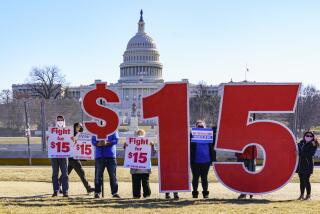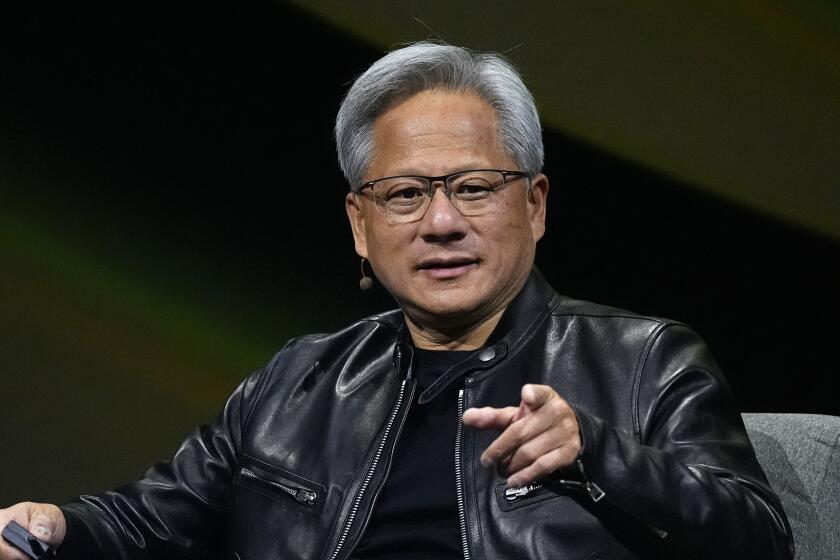Today is Equal Pay Day. The wage gap between men and women remains ‘stuck’
Equal Pay Day is Tuesday, and any progress companies have made toward tackling pay disparities between male and female employees comes without much evidence of change on the statistical front.
The most recent annual government data show women who work full time, year round, still earn 80 cents for every dollar men earn, a level that has hardly budged over the last decade after rising from about 60 cents in 1980.
“The wage gap seems to be stuck,” said Vicki Shabo, vice president for workplace policies and strategies at the National Partnership for Women and Families, which cites annual figures — rather than weekly figures showing an 82-cents-to-the-dollar disparity — to avoid fluctuations that come with seasonal work.
Equal Pay Day, launched in 1996, is meant to symbolize how far into the year a woman must work in order to earn the same amount that a man earned the previous year.
The gap exists, to varying degrees, across jobs and industries. Personal financial advisors show the largest disparity, with women’s median weekly earnings at 59% that of men’s, according to a new analysis by the Institute for Women’s Policy Research. Only in two occupational categories — “dining room and cafeteria attendants and bartender helpers” and “wholesale and retail buyers, except farm products” — do women earn more than men, while in 107 occupations women are paid less than 95% of what their male counterparts make, the report found.
That is still not an apples-to-apples comparison. Controlling for occupation, industry, education, experience and other factors that influence salary, the nation’s gender pay gap is less than 3 cents, according to a new PayScale survey of more than 2 million people.
But the overall 20-cent gap matters because it reflects that far fewer women than men are in executive roles and other higher-paid positions, and that the industries in which women are more likely to work tend to be lower paid. The lower lifetime earnings make it harder to pay back student debt, buy a home or support a family, putting women — 15 million of whom are heads of households — at higher risk of financial insecurity, Shabo said.
The wage gap grows the older women get, as many more men than women move into senior roles, and research suggests that is driven in part by career interruptions to have children. Women are five times as likely as men to take a break from work to raise kids, and employees who leave the workforce for a year or more find that their pay upon returning is 7% less than a currently employed person seeking the same job, according to PayScale’s report.
Despite the slow progress, Shabo is optimistic that change is afoot as attention to issues of gender equity soars.
“We’re in a very unique moment in the ethos of this nation,” she said.
Growing movements to raise the pay of care workers, plus teacher strikes in West Virginia and Oklahoma, are forcing society to rethink the value of the jobs women tend to do, she said.
Several cities and states have passed legislation prohibiting employers from asking job candidates about their prior salaries so as not to perpetuate lowball offers. And on Monday, the U.S. 9th Circuit Court of Appeals ruled that employers may not consider prior salaries in setting a person’s pay.
Meanwhile, more companies are proactively fixing pay inequities among their employees. Last month, Starbucks announced 100% gender and racial pay equity for employees performing similar work at its U.S. company-owned stores, drawing praise from women’s advocacy groups that hope it serves as a model for the retail sector.
JP Morgan Chase in February became the latest bank to disclose a pay gap of 1%, after adjusting for factors such as job role, seniority and geography. That disclosure came as legislation in Britain required large employers, including multinational banks such as JP Morgan, to report their raw pay gaps by an April 4 deadline, not adjusting for job role and other factors, which showed far larger disparities resulting from many more men holding senior positions. In the United States, an Obama-era policy that would have required large companies to report to the government what they pay employees by race and gender was halted by the Trump administration in August.
In the end, persistent pay gaps are less about pay and more about career barriers, said Haig Nalbantian, co-founder of Mercer Workforce Sciences Institute, which works with large global companies.
Companies on the cutting edge of addressing the issue are digging into the root causes preventing women from getting the same positions as their male colleagues and designing solutions, he said.
But even initiatives meant to address those career barriers, such as more flexible schedules or generous paid leave, are proving to be insufficient, Nalbantian said. Companies with such policies are not seeing higher promotion rates for women, his research has found, perhaps because employees fall out of consideration when they’re not around.
“You have to make sure you’re also paying attention to the career progression,” Nalbantian said. “If it’s not managed well and leaders are not cognizant of this drag, they’re going to end up not having enough women in the pipeline.”
aelejalderuiz@chicagotribune.com
ALSO
The other wage gap: Moms are paid less than dads
Equal Pay Day is a reminder of the importance of negotiating a salary
Trump administration halts Obama-era rule to shrink the gender wage gap
More to Read
Inside the business of entertainment
The Wide Shot brings you news, analysis and insights on everything from streaming wars to production — and what it all means for the future.
You may occasionally receive promotional content from the Los Angeles Times.










